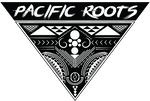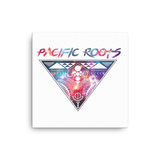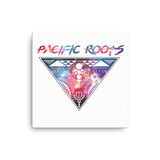Design: Pacific Roots "Polynesian Triangle" by Vincent J. Tofilau.
The new Pacific Roots logo not only portrays the beautiful motifs of the various countries that make up the Pacific, but it is also a reflection of the views, values and beliefs of Pacific Roots as a whole and ties directly to the creator and entrepreneur whose vision and drive has made Pacific Roots the brand that it is today.
The triangle is the Pe’a or Tama-sa, the motif to which the term for those who are dressed in the attire of the ancients are commonly called. Always hidden, this motif represents the sacred relationship that one has with those around him. The respect one must have and not show certain parts of himself. Restraint, and self-control. A reminder that we must know our place and act with civility.
The 7 circles in the center represent the 7 islands which form the Island territory of American Samoa, the birthplace of Pacific Roots owner and the current location of its headquarters.
The curls around the circles are called Koru by the Maori and is a symbol for new beginnings, personal awakening, growth, maturity and the spirit of rejuvenation and peace. It can also be seen as wild boar tusks, proudly worn by our ancient ancestors which symbolizes strength, power and hard work.
This symbol represents Ta’aroa, the supreme God of Tahiti, and whose name is similarly known throughout the Polynesian islands as Tagaloa, Takaroa, and Kanaloa. It is said that he created all, including himself. The semi-circle beneath him, represents the lower shell from which he was born. This symbol we have taken to represent the past- its power over us, and the spirit of creation.
These symbols represent the sun, the waves of the ocean and the shell of the turtle. We have taken these symbols to represent the future that shines bright and the vast oceans of opportunity out there for us. The turtle shell reminds us that we must harden ourselves and strengthen our resolve for the long journey ahead.
The 5 coconut leaf ribs, flanked by Gogo, or seabirds, represent not only what is considered the tree of life, but represent the five general routes that our early Polynesian ancestors are thought to have taken through the Pacific. The birds represent the skill that they had, earning them the title of Master navigators and allowing them to travel freely throughout the Pacific and reminds us of the importance of the ocean and all it provided for us. These experiences- their journey, tie us to our ancestors, and we have these symbols to remind us of where we came from. Our roots.
The circles, coconut leaf and swirls are set in a symbolic representation of the Tuiga, or traditional head dress worn by the Taupou, or the daughter of a high chief during ancient religious traditional Ava ceremonies. We use this imagery to represent beauty and femininity.
The two circles, or Gogo togitogi represent the old Gods, and the three triangles, a spear or a spear head. We use this symbolism to represent initiative and masculinity.
The three arches on each side are symbols of the rafters seen within the design of a fale, or traditional Samoan house. This is representative of our commitment to supporting our families and our community.
The nets represent hard work and prosperity. Two cornerstones on which we have built ourselves.
The modified fence or ahu ahu mataroa, represents strength, athleticism and a new challenge. This is symbolic of the new challenges we face as a people, and how we must face it head on.
The Hawaiian motifs are an acknowledgement of the beautiful islands from which Pacific roots was born as an idea, and where it manifested itself.
Cultural background: Over 1,000 years ago, our Austronesian ancestors successfully explored and settled across Oceania. Most islands around the Pacific are quite minuscule in comparison to other parts of the world and are widely spread out across thousands of miles.
The sailing route our ancestors took spanned larger than the entire North America and Europe combined! So the ability to successfully navigate back and forth was a prized skilled amongst each respective culture.
Our ancestors were able to accomplish sea voyages through mastering the stars, ocean waves, weather, clouds, colors of the sea/sky, and the flight of the birds. Experiences and teachings would be generationally passed down through oral tradition.
Samoan roots: From Lapita pottery discovered in Mulifanua, archeologists state the Samoan Islands were first settled around 3,000 years ago. In 1768, European explorer Louis-Antoine de Bougainville named us "The Navigator Islands". Lead under Charles Wilkes, the first American expedition did not land in Samoa until 1839.
There is rich history to be found between Tonga, Fiji, and Samoa, all prior to the Europeans navigating to Samoa. Through oral history, we know of many shared battles, royal marriages between the islands, similar cultural traits, and the teaching of the sacred art of the "tatau" (tattoo).
Here's an excerpt from the Pacific Guardians (http://pacificguardians.org/blog/2015/01/17/polynesians-are-all-samoans-says-captain-of-voyaging-canoe-hokulea/.html):
“Quite frankly, we Polynesians are all Samoans because that’s where we all started from thousands of years ago,” Kalepa Baybayan, captain of Hokule’a told Pacific Guardians.
“The genesis, the seed from there [Samoa] spread throughout all of Polynesia.”
#PacificRoots #WearYourHeritage
This canvas print is sure to make a statement in any space. It's hand-stretched on a poly-cotton blend canvas with a matte finish coating.
• Fade-resistant
• 20.5 mil-thick poly-cotton blend canvas
• Hand-stretched
• Hand-glued solid wood stretcher bars
• Matte finish coating
The new Pacific Roots logo not only portrays the beautiful motifs of the various countries that make up the Pacific, but it is also a reflection of the views, values and beliefs of Pacific Roots as a whole and ties directly to the creator and entrepreneur whose vision and drive has made Pacific Roots the brand that it is today.
The triangle is the Pe’a or Tama-sa, the motif to which the term for those who are dressed in the attire of the ancients are commonly called. Always hidden, this motif represents the sacred relationship that one has with those around him. The respect one must have and not show certain parts of himself. Restraint, and self-control. A reminder that we must know our place and act with civility.
The 7 circles in the center represent the 7 islands which form the Island territory of American Samoa, the birthplace of Pacific Roots owner and the current location of its headquarters.
The curls around the circles are called Koru by the Maori and is a symbol for new beginnings, personal awakening, growth, maturity and the spirit of rejuvenation and peace. It can also be seen as wild boar tusks, proudly worn by our ancient ancestors which symbolizes strength, power and hard work.
This symbol represents Ta’aroa, the supreme God of Tahiti, and whose name is similarly known throughout the Polynesian islands as Tagaloa, Takaroa, and Kanaloa. It is said that he created all, including himself. The semi-circle beneath him, represents the lower shell from which he was born. This symbol we have taken to represent the past- its power over us, and the spirit of creation.
These symbols represent the sun, the waves of the ocean and the shell of the turtle. We have taken these symbols to represent the future that shines bright and the vast oceans of opportunity out there for us. The turtle shell reminds us that we must harden ourselves and strengthen our resolve for the long journey ahead.
The 5 coconut leaf ribs, flanked by Gogo, or seabirds, represent not only what is considered the tree of life, but represent the five general routes that our early Polynesian ancestors are thought to have taken through the Pacific. The birds represent the skill that they had, earning them the title of Master navigators and allowing them to travel freely throughout the Pacific and reminds us of the importance of the ocean and all it provided for us. These experiences- their journey, tie us to our ancestors, and we have these symbols to remind us of where we came from. Our roots.
The circles, coconut leaf and swirls are set in a symbolic representation of the Tuiga, or traditional head dress worn by the Taupou, or the daughter of a high chief during ancient religious traditional Ava ceremonies. We use this imagery to represent beauty and femininity.
The two circles, or Gogo togitogi represent the old Gods, and the three triangles, a spear or a spear head. We use this symbolism to represent initiative and masculinity.
The three arches on each side are symbols of the rafters seen within the design of a fale, or traditional Samoan house. This is representative of our commitment to supporting our families and our community.
The nets represent hard work and prosperity. Two cornerstones on which we have built ourselves.
The modified fence or ahu ahu mataroa, represents strength, athleticism and a new challenge. This is symbolic of the new challenges we face as a people, and how we must face it head on.
The Hawaiian motifs are an acknowledgement of the beautiful islands from which Pacific roots was born as an idea, and where it manifested itself.
Cultural background: Over 1,000 years ago, our Austronesian ancestors successfully explored and settled across Oceania. Most islands around the Pacific are quite minuscule in comparison to other parts of the world and are widely spread out across thousands of miles.
The sailing route our ancestors took spanned larger than the entire North America and Europe combined! So the ability to successfully navigate back and forth was a prized skilled amongst each respective culture.
Our ancestors were able to accomplish sea voyages through mastering the stars, ocean waves, weather, clouds, colors of the sea/sky, and the flight of the birds. Experiences and teachings would be generationally passed down through oral tradition.
Samoan roots: From Lapita pottery discovered in Mulifanua, archeologists state the Samoan Islands were first settled around 3,000 years ago. In 1768, European explorer Louis-Antoine de Bougainville named us "The Navigator Islands". Lead under Charles Wilkes, the first American expedition did not land in Samoa until 1839.
There is rich history to be found between Tonga, Fiji, and Samoa, all prior to the Europeans navigating to Samoa. Through oral history, we know of many shared battles, royal marriages between the islands, similar cultural traits, and the teaching of the sacred art of the "tatau" (tattoo).
Here's an excerpt from the Pacific Guardians (http://pacificguardians.org/blog/2015/01/17/polynesians-are-all-samoans-says-captain-of-voyaging-canoe-hokulea/.html):
“Quite frankly, we Polynesians are all Samoans because that’s where we all started from thousands of years ago,” Kalepa Baybayan, captain of Hokule’a told Pacific Guardians.
“The genesis, the seed from there [Samoa] spread throughout all of Polynesia.”
#PacificRoots #WearYourHeritage
This canvas print is sure to make a statement in any space. It's hand-stretched on a poly-cotton blend canvas with a matte finish coating.
• Fade-resistant
• 20.5 mil-thick poly-cotton blend canvas
• Hand-stretched
• Hand-glued solid wood stretcher bars
• Matte finish coating




